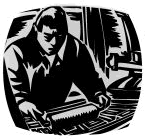|
|
|
 Manfred, when and where did you become a typesetter and what attracted you to typography? Manfred, when and where did you become a typesetter and what attracted you to typography? |
In 1947, two years after the war, I was 15 and hadnt returned to junior high school. A teacher recommended that I graduate in four years in a special course offered in Berlin. I had been playing with rubber stamp single letters for years; I was a bookworm and I didnt want to learn bureaucracy in the Berliner Red town hall. I was driven to the typesetter's apprenticeship more intuitively than based on information, because there was nobody who was able to teach me anything about it.
So I applied to the Kurier, the news mag for the French occupation forces with a printing office (German company + branch of the Imprimerie National where the printed material for the French army in Germany was made).
Type design was taught in the technical school, e.g. documents and job printing, also books. By the way, typesetters historically enjoyed a privilege of higher education: they were allowed to carry a sword, a sort of dagger. |
|
|
|
|
|
The assistant’s test which corresponds to the skilled apprentice’s final exam, covered not only speed-setting (goal: 1500 marks per hour!) but also design-jobs like draft and layout - this has been standard since Gutenberg. |
|
|
Font: Typesetter TV
|
|
Manfred in 1974
|
|
|
| |
 Under the ‘dozen year Reich’ you experienced the prohibition of Fraktur and the nonsense about the Schwabacher Jewish Typeface, what can you tell us about it? Under the ‘dozen year Reich’ you experienced the prohibition of Fraktur and the nonsense about the Schwabacher Jewish Typeface, what can you tell us about it? |
I can only say for myself that I had been learning English enthusiastically in Arnswalde, not far from Szczecin in which I began ‘German high school’ from 1942 on. This language teaching was free of policy and was fun up to the drill: “push your chin forward and tongue close to the teeth.”
Well, we had to learn another kind of writing after ‘Sütterlin’ - so Latin was just another learning unit, I didn't comprehend this cultural break at all, being 10 years of age, nor did the adults: some believed in ‘final victory’, the others anticipated the dreadful end. So did I. Besides, there was no order to burn the Fraktur books like many others; the old writings remained with us. I became aware of the cultural type-shock gradually with the beginning of the apprenticeship. |
|
 I can hardly imagine that - if there was a prohibition of Serifs from one day to another, I'd surely have a problem with it. I can hardly imagine that - if there was a prohibition of Serifs from one day to another, I'd surely have a problem with it. |
| Learning Russian would have been more difficult. In 1945 we used to see Cyrillic type daily on winner-billboards, but the Russians were realistic enough to add everything in German – Latin. Hitlers may come and go, but the German people will remain, original quote from Stalin, May 1945, was heard a hundred times in Berlin’s streets. It was a kind of comfort, because Hitler wanted actually that this ungrateful people would perish. |
|
 Fortunately they were spared this fate. What was the next step after your typographic apprenticeship? Fortunately they were spared this fate. What was the next step after your typographic apprenticeship? |
| In 1950, I attended evening classes in design by IG Druck und Papier (now Ver.di) and Günter Gerhard Lange. |
|
|
|
|
|


